Read Reviews
The Best Log Stores
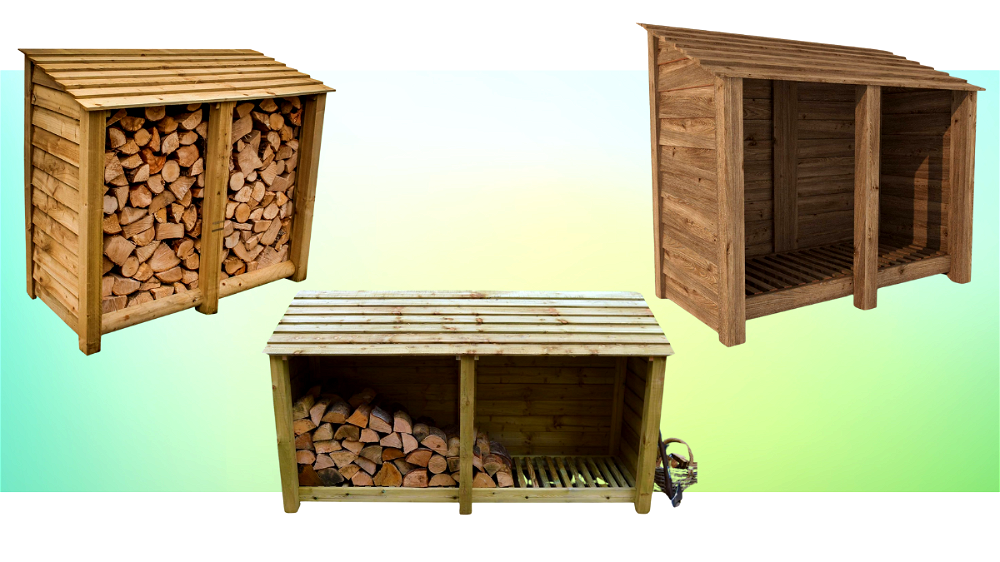
-
Best log store overall - Rutland County Garden Furniture Cottesmore Log Store
-
Best large log store - Normanton Hand Made Wooden Log Store
-
Best medium log store - Garden Supplies Centre Log Store
-
Best budget log store - Easipet Wooden Log Store
-
Best log store design - Charles Bentley Heavy Duty Wooden Log Store
-
Best extra large log store - The Garden Supplies Centre Extra Large Log Store
-
Best for practicality - Charles Bentley Heavy Duty Wooden Large Double Log Store
Log Store Reviews
1. Rutland County Garden Furniture Cottesmore Log Store
Best log store overall
- Very sturdy and durable construction
- Well ventilated so damp logs are able to dry
- Most users find this log store relatively easy to assemble especially with an extra pair of hands
- At just 4 ft tall, this log store is compact enough for even very small outdoor spaces
- Heavy to manoeuvre so needs to be installed as near as possible to where you’d like it
- If placed in a very exposed area, water may get through from the ventilation gap at the back
- Best stored on a hard surface, as when filled with logs the legs may sink into soft ground
- Capacity
- 280 standard logs
- Weight
- 50kg
- Elevated Base
- Yes
- Material
- Pressure treated timber
- Kindling Shelf
- Yes
- Design
- 4.6
- Capacity
- 4.4
- Durability
- 4.7
- Assembly Ease
- 4.5
- Value for Money
- 4.5
If you’re conscious about burning responsibly-sourced logs, you’ll likely be looking for a wood store that is similarly environmentally conscientious. This Rutland County Garden Furniture Cottesmore Log Store is made from FSC-approved wood which comes from sustainable sources.
The pressure-treated timber is not only responsibly sourced, but treated to protect it from rot and insect infestations. The overall construction is sturdy as well, with thick posts supporting the feather board edges and slanted roof.
When it comes to protecting the logs inside, there is good ventilation provided by the raised, slatted base and gap out the top. The roof has a reasonable overhang on all sides to prevent rain from getting too near the logs as well.
The dimensions are 150 x 127 cm and it will hold 0.9 m³, which is approximately 280 standard logs. If you’re burning a fire for a couple of evenings a week, this will likely be a good size.
In terms of assembly, although putting the log store together isn’t too difficult, you’ll probably want to use a power screwdriver if you have one; there are 40 screws to get in altogether and the wood is quite hard, so it’s a tiring task to do manually.
Did you find this review helpful?
2. Normanton Hand Made Wooden Log Store
Best large log store
- Assembly takes around two hours and the instructions are generally easy to follow
- The screw holes are pre-drilled
- Large capacity that is capable of storing approx. 450 standard logs
- Slats and raised base keeps logs well ventilated so they can dry out
- May be too wide for smaller outdoor spaces
- Difficult to manoeuvre due to weight and size so best built in situ
- Instructions do not always come provided, although they can be found online
- Capacity
- 450 standard logs
- Weight
- 50kg
- Elevated Base
- Yes
- Material
- Pressure treated timber
- Kindling Shelf
- No
- Design
- 4.5
- Capacity
- 4.8
- Durability
- 4.7
- Assembly Ease
- 4.4
- Value for Money
- 4.4
If you frequently burn through a large number of logs, you might struggle to keep enough close to hand for when you need them.
This Normanton Hand Made Wooden Log Store fits around 450 standard logs, yet is still fairly compact and can be placed in easy-reach of the house.
At 230 cm wide by 125 cm tall, you’ll likely find space near to the back door for this unit –hopefully reducing the number of trips you have to make to further-afield wood reserves when the cold rain is pouring down in winter.
It’s constructed from FSC-approved wood that has been pressure treated, so it’s equipped to stand up to our versatile UK climate. The supportive posts are solid and large, at 7.6 x 7.6 cm, and the feather-board edge fits together well; it’s a sturdy, well-ventilated structure that helps keep logs dry.
In order to protect the logs, the base is raised off the floor. If you’ve struggled to dry out logs in the past because they’ve been resting on the ground, this raised unit keep them ventilated and stops them from sitting in residual rain water.
The wood is tough, which is a good sign, but during assembly you’ll likely require a power screwdriver even though the holes are pre-drilled. Putting the log store together can take around two hours.
Overall, this is a strong log store which will make it a lot easier to have logs to hand for wood-burning fires or stoves in the winter. As long as it is positioned correctly outside, it’s well equipped to keep logs dry.
Did you find this review helpful?
3. Garden Supplies Centre Log Store
Best medium log store
- Assembly can be done in around one hour
- Compact design suitable for most outdoor spaces
- The slatted bottom offers good ventilation, helping logs season well
- Comes with extra screws in case you misplace any
- Capacity to hold approximately 300 logs
- While assembly is relatively easy, an extra pair of hands is needed
- At around 60 kg, it's very heavy to move once assembled so best installed in situ
- May sink into soft ground so best stored on a hard surface
- Capacity
- 300 standard logs
- Weight
- 60kg
- Elevated Base
- Yes
- Material
- Pressure treated wood
- Kindling Shelf
- No
- Design
- 4.7
- Capacity
- 4.4
- Durability
- 4.6
- Assembly Ease
- 4.6
- Value for Money
- 4.6
Keeping logs dry is no mean feat, especially in certain parts of the UK where the wind and rain can be somewhat relentless. Fortunately, this Large Log Store from The Garden Supplies Centre is a great medium-size log store that won’t let a squall or a flurry permeate its walls.
Given that it’s a relatively compact unit, at 150 cm wide and 129 cm tall, it can fit into smaller spaces; you might even be able to tuck it into a side-alley if you have one around your house. The capacity is just under 1 m³ which means it can fit somewhere around 300 logs.
The front is open, so positioning it out of prevailing winds will benefit your logs, but generally the pressure-treated wood construction, along with the feather-board sides, and overhanging roof are well designed to keep precipitation out.
Assembly doesn’t take too long – around an hour with the help of two people, though you might want to wear gloves as splinters can come off the wood whilst putting it together.
The raised base is just another feature that can help protect logs from our damp climate – keeping them off the ground so that they have a chance to dry out and season correctly.
One thing to note: despite being relatively compact, this log store is surprisingly heavy at 60 kg – two people will likely be required to move it around, and you’ll do yourself a favour by assembling it close to its destined location.
Did you find this review helpful?
4. Easipet Wooden Log Store[ SAVE 6% ]
Best budget log store
- The felt roof offers an extra layer of protection against the elements
- The raised floor prevents damp and aids ventilation to help dry and season your logs
- Assembly is easy with clear instructions supplied
- As the smallest log store featured here, it's the best option to tuck into small spaces
- The roof overhang is not very large, so some of the lower logs may sometimes be exposed to rain water
- Slightly less durable construction than some other units - best kept in a more sheltered area
- Care should be taken when filling to capacity as excessive weight may cause strain on the construction
- Capacity
- 225 standard logs
- Weight
- 22kg
- Elevated Base
- Yes
- Material
- Fir and plywood
- Kindling Shelf
- No
- Design
- 4.3
- Capacity
- 4
- Durability
- 4.4
- Assembly Ease
- 4.6
- Value for Money
- 4.6
For smaller spaces, or households that don’t burn as much wood, a compact unit like the Easipet Wooden Log Store will keep logs dry without taking up too much space. Due to its inexpensive price tag, it’s also a great budget-friendly option.
At 116 cm wide and 123 cm high, it has a capacity of 0.75 m³ (which equates to about 225 standard logs) whilst taking up a lot less room than a lot of the other log stores featured here. If you’re only burning a living-room fire for a few nights a week, this should be an adequate store to keep enough wood nearby.
Also, unlike most other stores, the roof has a protective felt covering which adds an extra waterproof layer. The wood construction itself is fir and plywood, and seeing as the holes are already drilled, it’s pretty easy to put everything together in under an hour using just a screwdriver.
The darker colour may appeal to some gardeners too, over the pine tones of other units, depending on the colour of the rest of your garden furniture. Either way, as a smaller unit, it can be tucked away relatively easily, even if you only have a small amount of space available.
It also makes a handy ‘additional’ store for positioning close to the house, giving easy access to fresh supplies of wood in winter weather.
Did you find this review helpful?
5. Charles Bentley Heavy Duty Wooden Log Store[ SAVE 21% ]
Best log store design
- The kindling shelf is a handy additional feature and can be installed at any height
- Water runs backwards, away from the logs, thanks to the sloped roof
- Very well ventilated to help your logs dry
- At 29kgs, this log store is much easier to move around the garden than others on the market
- Suitable for compact and small gardens as measures just 119cm across
- Drainage needs to be considered - water run backwards but may pool around wall if position too close
- Some customers find the base isn’t particularly sturdy under the weight when full to capacity
- Not as sturdy as others on the market, especially when filled to capacity
- Capacity
- Not listed
- Weight
- 29kg
- Elevated Base
- Yes
- Material
- Nordic spruce wood
- Kindling Shelf
- Yes
- Design
- 4.3
- Capacity
- 4
- Durability
- 4.2
- Assembly Ease
- 4.5
- Value for Money
- 4.3
This well-designed Heavy Duty Wooden Log Store has an additional area for keeping kindling dry – great news for getting fires started quickly and effectively! The clever design incorporates a separate shelf that can be used to store smaller wood and kindling.
Measuring 119 cm wide and 152 cm tall, it has a capacity of 0.76 m³ which will accommodate approximately 225 logs. Of course, this depends where you position the aforementioned shelf (naturally, if the shelf is lower it holds less logs and more kindling). The shelf can actually be moved to any height, so it’s customisable depending on how you want to arrange your log store. It’s not supported at the back though, so heavier logs can’t be placed on the shelf.
In terms of construction, this log store is a bit more interesting than the others featured here – it’s made from the wood of a Nordic Spruce (more commonly seen in its original tree form at Christmas!), which is generally stronger than pine.
This wood has an attractive silvery finish, and doesn’t discolour as much as pine wood. It’s also been pressure treated, so doesn’t need any further treatment against rot for the first few years.
The slatted sides and raised base maintain good circulation, which helps the logs season and dry out properly. Also, unlike a lot of other log stores, the roof is angled backwards which encourages water to run off away from the logs. The only thing to watch out for is that the log store isn’t positioned too close to a wall, as this could cause the water to pool as it runs off the back.
Assembly is best done with two people; just to have someone else to help support the structure whilst you put it together. It’s pretty light once completed, at 29 kg, so not as difficult to move into position as some of the heavier wood stores.
Did you find this review helpful?
6. The Garden Supplies Centre Extra Large Log Store
Best extra large log store
- The best option for large gardens thanks to its large capacity of 2m³
- Users have reported the log store maintaining its quality even after a few years of use
- Has a very smart design that looks good in most gardens
- Drilling is required during assembly which can be tricky for those without DIY experience
- Very heavy rain may drip between the roof sections, so some customers have opted to cover the roof with felt
- The assembly instructions aren’t particularly helpful, with very small pictures
- May be too large for smaller outdoor spaces
- Capacity
- 600 standard logs
- Weight
- 120kg
- Elevated Base
- Yes
- Material
- Pressure treated timber
- Kindling Shelf
- No
- Design
- 4.5
- Capacity
- 5
- Durability
- 4.6
- Assembly Ease
- 4.6
- Value for Money
- 4.5
Whether the majority of your heating comes from wood-burning appliances, or you just love to keep a big fire burning every day in winter, one way to make sure your wood store is always well stocked is to get hold of something like the Garden Supplies Extra Large Log Store which holds approximately 600 standard logs.
Its 2 m³ capacity is the largest on this list, making it one of the best log stores for households that burn through a lot of wood.
Of course, any log store that can hold 600 logs is bound to take up a fair amount of space, and this 262 cm wide, 131 cm tall unit needs quite a large area to stand in. It’s therefore best suited to medium/large outdoor spaces, unless you don’t mind having a log store as the primary focus in your garden.
The wooden construction, with thick 7.6 cm x 7.6 cm supportive pillars and feather-board sides, is fully pressure treated and should stand up well to the onslaught of the UK climate without suffering from rot or insect infestations.
Overall, the waterproofing is adequate, although adding some felt to the top would deter any of the leaks that do occasionally get in. That said, the overhang sticks out well past the contents, which helps any water running off of the roof skip over the logs.
In terms of assembly, two people and an electric screw driver can get this log store together relatively quickly, although the instructions are not the easiest to interpret.
Did you find this review helpful?
7. Charles Bentley Heavy Duty Wooden Large Double Log Store[ SAVE 22% ]
Best for practicality
- The kindling shelf can be installed at any height to suit your storage needs
- The slatted design ensures the logs are well ventilated
- Lightweight and relatively easy to move around the garden once installed if needed
- Very easy assembly although an extra pair of hands is needed
- There is no roof overhang which means logs at the front are not well protected from the elements
- May bow on the edges if filled with damp and heavy wood
- Some customers have opted to cover with tarpaulin in the winter months for better weather protection
- The legs aren’t long so to prevent damp you may wish to raise the log store slightly off the floor
- Capacity
- 300 standard logs
- Weight
- 39kg
- Elevated Base
- Yes
- Material
- Nordic spruce wood
- Kindling Shelf
- No
- Design
- 4.1
- Capacity
- 4.4
- Durability
- 4.2
- Assembly Ease
- 4.5
- Value for Money
- 4.2
For a wood store with a capacity of 1.15 m³ (that’s over 300 standard-size logs), the Charles Bentley Heavy Duty Log Store doesn’t take up as much space as you might expect. With a width of 177 cm, and a height of 152 cm, it’s one of the most practical log stores for small/medium spaces; its footprint is comparatively small given how much wood it can hold.
Whilst it’s certainly not the smallest wood store featured here, it does strike a good balance between capacity and size, which might make it a good choice for households without much space who burn quite a lot of wood.
Made from Nordic Spruce wood, it has slatted side panels instead of feather-board, which create more wind flow around the logs and help moisture to evaporate. Combined with the raised base, and backwards-angled roof, there are several design features which contribute to keeping the logs dry.
There is a kindling shelf that can be positioned wherever you want it – given that this is a double unit, you could even have half a side of kindling if you wanted, whilst still leaving a lot of room for logs.
Whilst there’s no front overhang on the roof, it is angled backwards to encourage water to flow away from the logs. And, there is an overhang on the sides which keeps too much rain from getting in through the slats.
If placed out of prevailing wind, this log store remains fairly protected from the elements.
Did you find this review helpful?
Compare Product Features
Use the dropdown to sort the table by the feature you want to see.
Rutland County Garden Furniture Cottesmore Log Store
- 4.5
- 280 standard logs
- 50kg
- Yes
- Pressure treated timber
- Yes
Normanton Hand Made Wooden Log Store
- 4.6
- 450 standard logs
- 50kg
- Yes
- Pressure treated timber
- No
Garden Supplies Centre Log Store
- 4.6
- 300 standard logs
- 60kg
- Yes
- Pressure treated wood
- No
Easipet Wooden Log Store
- 4.4
- 225 standard logs
- 22kg
- Yes
- Fir and plywood
- No
Charles Bentley Heavy Duty Wooden Log Store
- 4.3
- Not listed
- 29kg
- Yes
- Nordic spruce wood
- Yes
The Garden Supplies Centre Extra Large Log Store
- 4.6
- 600 standard logs
- 120kg
- Yes
- Pressure treated timber
- No
Charles Bentley Heavy Duty Wooden Large Double Log Store
- 4.3
- 300 standard logs
- 39kg
- Yes
- Nordic spruce wood
- No
How to Choose The Best Log Store
There are few things more pleasant than the luxury of warming yourself by a log-burning fire in the depths of winter.
And, equally, there are few things worse than realising you don’t have wood fuel when you need it, or that the logs you do have are too damp to burn.
Preparing and seasoning wood needs to be done long before you actually need to use your wood burner. A log store is a great way to keep your wood safe and dry, preparing it for the winter months.
There are quite a few variations of these storage units available, so if you’re looking for the best log store for your garden, the following information should help you get more acquainted with the different options:
READ NEXT: The Best Log Splitters
The Benefits of Using a Log Store
If your logs are close to hand in a log store, you’ll find it easier to prepare your log-burning fire or stove and keep it burning. It can be very easy to just keep a small supply of wood by the fireplace, but once it’s been burnt you might be tempted to pop the heating on. A log store will allow you to store more firewood close to the house, so you won’t have to go far to get more in.
Having a log store also means you can buy more wood in advance, and season any green wood that you have cut.
It can take between 6 months – 1 year to season fresh ‘green’ wood. The moisture content needs to get down to 20% before it is suitable for burning. The best log stores are well ventilated, which helps water be ‘wicked’ away from logs and dry them out.
You might normally buy/cut wood and then just leave it out in the garden, elevated on pallets or simply resting on the floor. This can work ok for a bit, but if there’s any bad weather, or just general humidity (we do live in the UK after all!), these logs will get damp.
Logs with more than a 20% moisture content aren’t great for burning for several reasons: not only are damp logs hard to light, but they can cause more serious problems. Burning damp logs they can create a lot of smoke, as well as tar build up in the chimney, which can have health consequences as well as be dangerous in the home.
You can check the dampness of logs before burning them by using a moisture meter.
Log stores keep logs protected from the worst of the weather, helping firewood stay dry so that it’s ready to use when you want it.
Choosing the Right Size Log Store
If you have an occasional fire during the evenings in winter, a small store will be sufficient. These normally have a capacity of less than 1 m³.
A log store with a 1 m³ capacity can hold approximately 300 standard logs. Therefore, a store with 0.5 m³ of space will hold roughly 150 standard logs, and so on.
Of course, it’s not just about how many logs you need; you’ll also need a smaller wood store if you have a smaller garden or outside area. No matter how frequently you have a log fire, you can only work with the space you’ve got!
For smaller spaces, it can help to look for a taller wood store that will keep a few more logs without expanding on the unit’s footprint.
If you need to season logs and want to build up a good stock, larger log stores can measure 1.5 m³+. Given that each cubic meter can store approximately 300 standard logs, 1.5 m³+ will store around 450+ standard logs.
These are more suited to people who are frequently burning logs in winter, or using a wood-burning stove as well as a fire. Some people choose to have both a large and small wood store, placing the smaller one closer to the house for easy access, with the larger one used to store and season more logs.
READ NEXT: The Best Log Splitting Axes
Buying a Long-Lasting Wood Store
As we’ve all no doubt learned the hard way, buying a cheaper product can seem like a good idea initially, but can cost us more in the long run when we have to replace it sooner.
To avoid this problem with your wood store, and make sure you’re getting something that will last, look for a unit constructed from pressure-treated wood.
Pressure-treated wood is protected from rot as well as insects such as woodworm. In many cases, this wood has been seen to last for around 15+ years (of course, environmental factors also play a part in its life potential). As a result, it’s a great material for a log store.
If the wood of the log store you’re looking at hasn’t been pressure treated, you should treat the wood yourself with water repellent sealer. This will need to be applied every 1 – 3 years to make sure the protection continues to work.
Even pressure-treated wood will benefit from an occasional water-sealant treatment as well. Applying a coat roughly once a year will help the wood stay protected from water damage (splitting, warping, etc.). This is especially important to do after you’ve had the log store for around 5 years.
The frame of the store should be constructed from sturdy posts, with the sides made from either slats or feather-edge panels.
Feather-edge panels allow some ventilation in but have smaller gaps between them than slats. Slats offer more ventilation, but don’t protect as well against the elements.
If you’re placing your log store in a windy area, where you think a lot of rain may be blown in if you have a unit with slats, feather-edge panels will be a better, more-protective, bet.
Good Ventilation and Weather Protection
Good ventilation is vital for drying and seasoning logs. Well-ventilated log stores will allow wind to whip between the logs, wicking moisture from them and helping them stay dry.
Good ventilation will also help prevent rotting and the development of fungi.
Ideally you want to find the balance between the wood store being as open as possible, but protected from the elements!
You should aim to place your log store in a south-facing direction, out of prevailing wind, where there is still a draft.
This way the logs will be dried by the warmth of the sun and ventilation from the draft, but they won’t have rain blown directly on them when the weather is bad.
Most log stores are slightly raised off the ground to protect the logs on the bottom layer from the elements and allow ventilation from the bottom up. This is quite vital when buying a log store and something you definitely want to look out for to help keep logs dry.
Expect Flat-Pack Assembly
Be prepared to have to put together the log store when it arrives.
It can be useful to check product reviews to see just how easy a certain product is to put together.
Some come better equipped with clear instructions than others!
The majority of log stores can be assembled within 1 – 2 hours. A lot of them come with pre-drilled, or at least started-off, screw holes.
Due to the large size of a lot of log stores, you’ll benefit from having a power screwdriver and an extra pair of hands to help out.
It’s also recommended to assemble the log store in situ – the larger models in particular can be very difficult and heavy to move once put together.
Log Store FAQs
Ideally, you should position your log store so that is is south facing. Where this is not possibly, try to ensure it is in a place with a good air flow so that the wood does not stay damp and begin to rot. If this ‘ideal’ position is quite far from the house, you may want to consider having a smaller store near the house for easy access in winter weather.
There are several things that can increase the life of your wood store. Having an elevated log store is a must. Furthermore, if you position your elevated log store on a concrete base, paving slabs, or blocks, it will be further protected from damp ground and stay rot free for longer. Even if your store is made from pressure treated wood, after a 5 – 10 years it is worth treating it again with a water-repellent sealer and repeating this every few years to ensure it lasts as long as possible.
This depends on the wood used, but it generally takes between 6 months and 2 years for firewood to dry out. Cut wood in the early spring ready for the following winter so that it can dry out in the summer months.
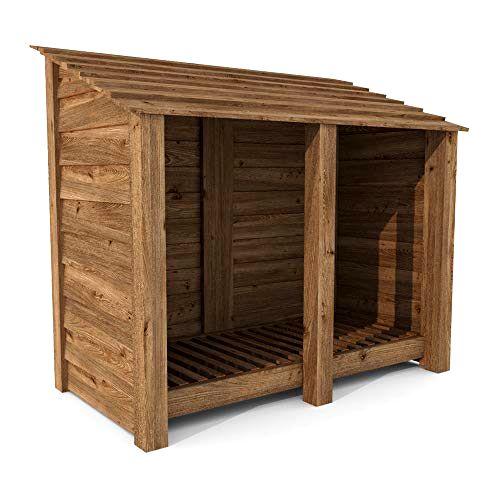
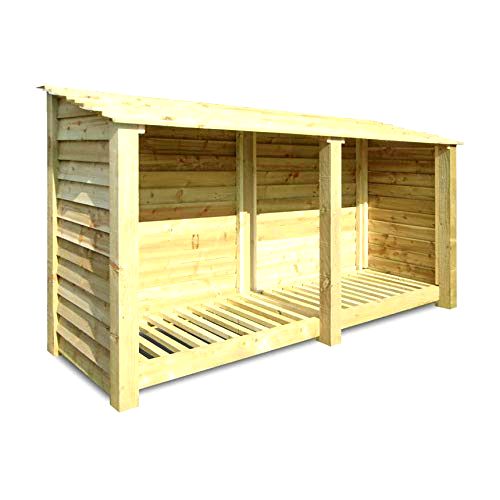
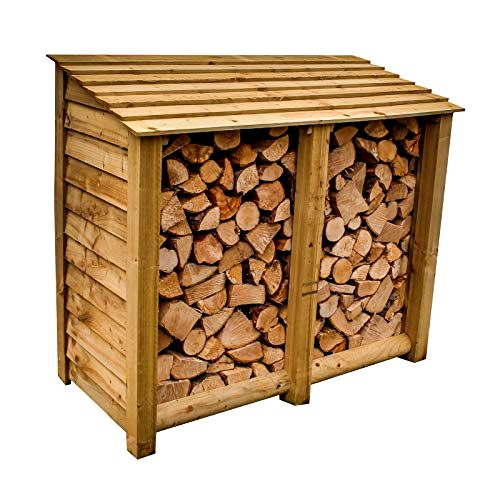
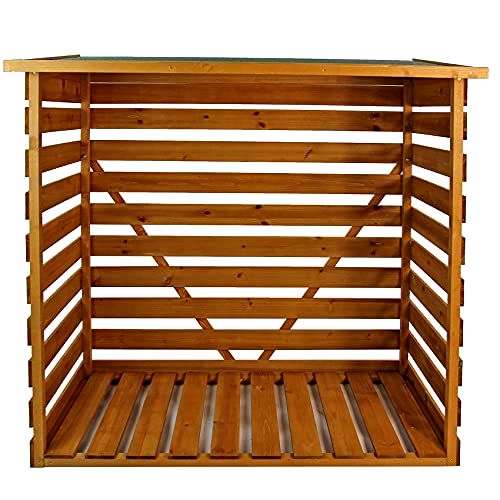
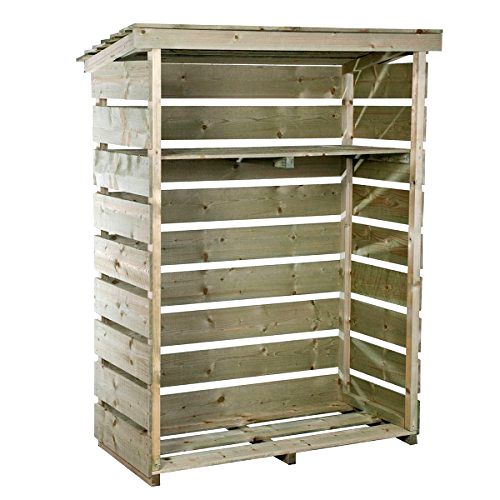
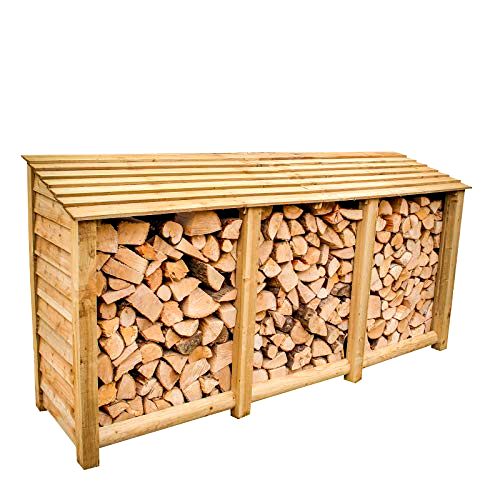
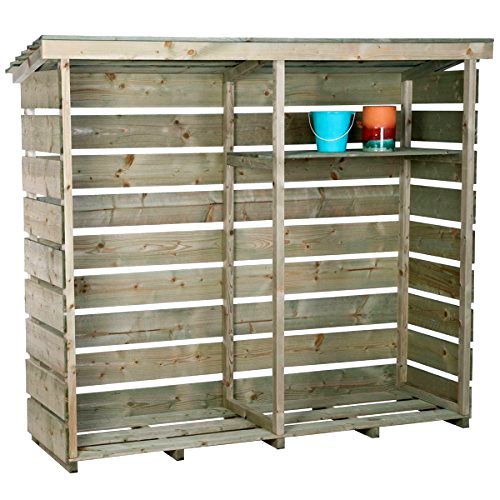

Share